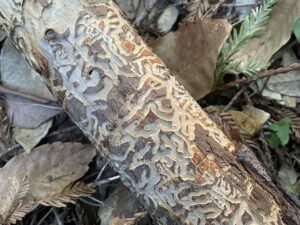My lungs remember a forest. It is late August of 2020. Plumes of smoke from the wildfires burning up California are pulled high and east in a thin yellow sky. In Oakland, the ruddy smoke settles thick and low. I step outside and inhale redwood, tanoak, Douglas fir; huckleberry, giant chain fern, maidenhair; salamander, skink, brush rabbit. Ashen particulates flurry down my throat.
Forests remember their fires, too. Meander through nearly any one of the protected parks in the Bay and before long you will bear witness to that memory. Behold the fire scar: blackened bark curtaining the trunk of a redwood open to reveal woody scar tissue inside. In some groves, like those of the old growth redwoods in Muir Woods, dozens of old giants bear some level of scarring, reminding us of fire’s adamant presence in California.
Fresh surface scars—like those now patching the trunks of Big Basin’s old-growth redwoods—can be stark signs of recent burn. A memory of loss, a chronicle of devastation. But dendrochronology invites us to look deeper. Take a chainsaw to a centenarian redwood, and you will likely find the secret inner whorls of old fire scars, nestled at regular intervals in this ligneous archive. Pushed inward by decades of growth, scars transform into layers of woundwood that bend elegantly outward from a thin black line of char.
If you lack a chainsaw or prefer to take a gestalt view of history—are not one to miss the forest for the tree stumps—there are simpler ways to picture fire’s place in a forest. You might see it in an abundance of sharp sprouts launching from redwood stumps; in strapping redwood seedlings shooting out of mineral-rich soil, sunlit through a canopy cleared of less fire-resistant tanoak and young fir; or in cohorts of adolescent redwoods, thick as a batch of gangly, growth-spurted seventh-graders, on newly cleared land. A density of redwoods may be a forest’s own fire scar.
Old-growth redwood forests, the kind that dominated the coast until the mid-1900s, were full of widely spaced, giant trees that had trunks you couldn’t wrap your arms around and were home to over 100 different species: clinging lichens and mosses; budding huckleberry and hemlock; burrowing woodpeckers. Out of the ashen carcasses of large snags, tenaciously green shoots grew “fairy rings” of trees. Enormous, ancient redwoods with basal hollows—fire-carved caverns known as “goose pens,” spacious enough to host a gaggle of geese—boast a structural complexity rare enough to welcome more than twice as many species of bat and bird as other trees can accommodate. Peek inside a goose pen and you may be awash in the fluttering wings of swifts, nuthatches, and swallows; perhaps you’ll spot the piebald pattern of an endangered marbled murrelet, the soft chocolatey plumage of a northern spotted owl, or the splashed rust of a Humboldt marten’s chest.
Dendrologists dating fire scars in stumps and logs estimate that fires burned in these coastal old-growth forests every six to 25 years, most likely in the fall. Because lightning-ignited fires in coastal redwoods are rare, and the use of fire to clear vegetation and steward game by Indigenous tribes in the area is well documented, the scars are widely understood to be evidence of prescribed burns. After European settler colonization, the fire regime changed drastically, as settlers determined that fires reduced the commercial value of the land.
After a century with significantly less fire and with greatly increased logging, more than half of our coastal redwood ecosystem is overly dense, lacking the brilliant biodiversity of the old-growth stands. Yet what is clear is that redwoods have always navigated, and survived, external threats. Sometimes, their annual rings coil so tightly that counting separate years becomes impossible, or pockets of fungal decay or rot blot out whole sections of stump, or idiosyncratic cessation of growth rings leave scientists puzzled as they try to imagine what caused the stunting. Scars, physical reminders of catastrophe, are not themselves catastrophic.
This summer, as I await fire season, I breathe deeply. My still-tender lungs prompt me to remember: a tree, an ecosystem, a history of land, an optimism of knowledge.
We carry fire scars inside us, too. With time, what will these scars make room for? What will grow?





